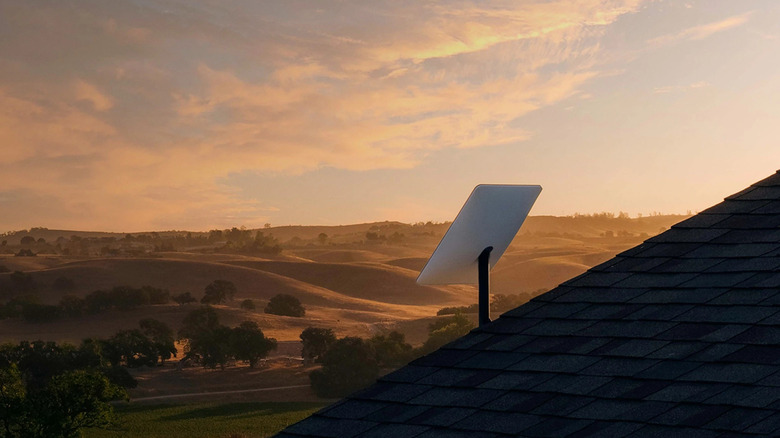Is Starlink Waterproof? Dish And Router IP Ratings, Explained
If you've been on the hunt for an alternative internet service provider for your remote location, then you've probably heard about Starlink. Starlink is a satellite network and ISP from Elon Musk's SpaceX. It's unlike traditional ISPs that heavily rely on cables and telephone lines to deliver internet to you. Instead, Starlink works by using a phased array antenna (a.k.a. dish) to communicate with the low-orbit satellite constellation in space, which, in turn, provides you with internet connectivity.
This wireless communication means you don't need to be close to a local cable node just to go online. As long as you have clear skies and your location is part of Starlink's coverage, you'll have a connection even if you're in the middle of nowhere. However, this satellite-to-dish system also means the worst place to install the Starlink dish is right inside your house. Yes, you do need to place it outside, where there are few obstructions. This exposes Starlink to the elements, though, and poses the question: is Starlink waterproof? Can it handle some rain and snow?
Decoding the IP ratings for the Starlink dish
The short answer to whether Starlink is waterproof is yes, it is. But there's a caveat — it's only up to a certain extent, which is evident in the IP ratings for the dish, power supply, and the router. These IP ratings have two numbers: the first tells you how well the equipment is protected from dust, and the second indicates its water resistance level. The different Starlink equipment comes in separate IP ratings. Let's go over the dish first.
For the Starlink dish, there are three different ratings, depending on the model. The Standard, Mini, and Enterprise are rated the highest at IP67, the High Performance and Flat High Performance at IP56, and the Standard Actuated at IP54. The 6 in IP67 means the dish is dust-tight, preventing any amount of dust from getting inside. The 5 in IP56 and IP54, on the other hand, suggests that they're sealed enough to minimize the entry of dust into the enclosure. Some still can, but it shouldn't be a cause of concern as the amount is small enough not to affect the device's overall functionality.
Meanwhile, the 7 in IP67 represents the equipment's protection against temporary water immersion. This means it can last for at most half an hour immersed in a meter (3.2 feet) of water. In comparison, the 6 in IP56 suggests that the dish can withstand powerful water jet projections, so brief downpours are generally fine. Finally, the 4 in IP54 shows that it's okay handling water splashes like light rain showers.
Understanding the IP ratings of the Starlink router and power supply
Similar to the Starlink dish, the router's IP rating also varies based on the model. It comes in one of two: IP56 for the Standard and IP54 for the Standard Actuated and High Performance. For both routers, their enclosures have matching dust resistance, which limit dust but not completely. In terms of waterproofing, though, they're completely different. IP56 is sealed enough to handle high-pressure water jets, while IP54 can only offer protection against splashes. But while the router's ratings are the same with the ratings of the High Performance, Flat High Performance, and Standard Actuated dishes, you can't use the router outdoors. It's specifically configured to only work inside.
On the other hand, all the Starlink power supplies have a single rating of IP66. This applies to the Standard, Mini, High Performance, Flat High Performance, and Enterprise. The first 6 digit means it's completely dust-proof like the Standard, Mini, and Enterprise's dishes. The second 6 digit indicates it's also resistant to strong water jets. You can't, however, submerge it in water unlike the IP67 dish.
The Starlink accessories like the cable and mount don't come with an IP rating. However, the cable is part of what makes the other equipment dust- and water-resistant. It features a locking mechanism that seals the component it's connected to, preventing/limiting the entry of dust and water and making it safe to expose the cable to the elements.
Tips and tricks to keep your Starlink better protected from the elements
While the Starlink equipment is built to tolerate the harsh outdoors to some degree, there are still a couple of installation and usage recommendations to keep in mind. During installation, make sure the cables are snugly plugged in to ensure the ports are sealed and ready for the elements. Don't try putting on layers of protective covers over the dish too. It isn't necessary and would only affect the connection of the dish to the satellites, leading to performance degradation.
If you live somewhere snowy, you need to consider not only the obstructions where you plan to install it but also the amount of snow that piles up in that spot. Snow can interfere with the satellite-to-dish communication and prevent the motors (for Standard Actuated and High Performance models) from reorienting the dish. That said, it's best to place the Starlink where you're sure the dish won't be entirely covered in snow. If some snow piles up on the dish, however, you can turn on the self-heating functionality (aptly named Snow Melt) to get rid of it.
For areas with hurricanes, Starlink recommends taking the dish and wirings inside to avoid damage. Once the hurricane passes, you can reinstall, provided the system is bone-dry. If it's only heavy rain with some lightning, though, you can get away with leaving it as is, but getting a lightning protection system is also a good idea. You may still, however, experience service interruptions during storms, which is one of the known disadvantages of Starlink. If there's excessive lightning, disconnect the router from power and the power supply from the wall outlet, so they're protected from power surges.



